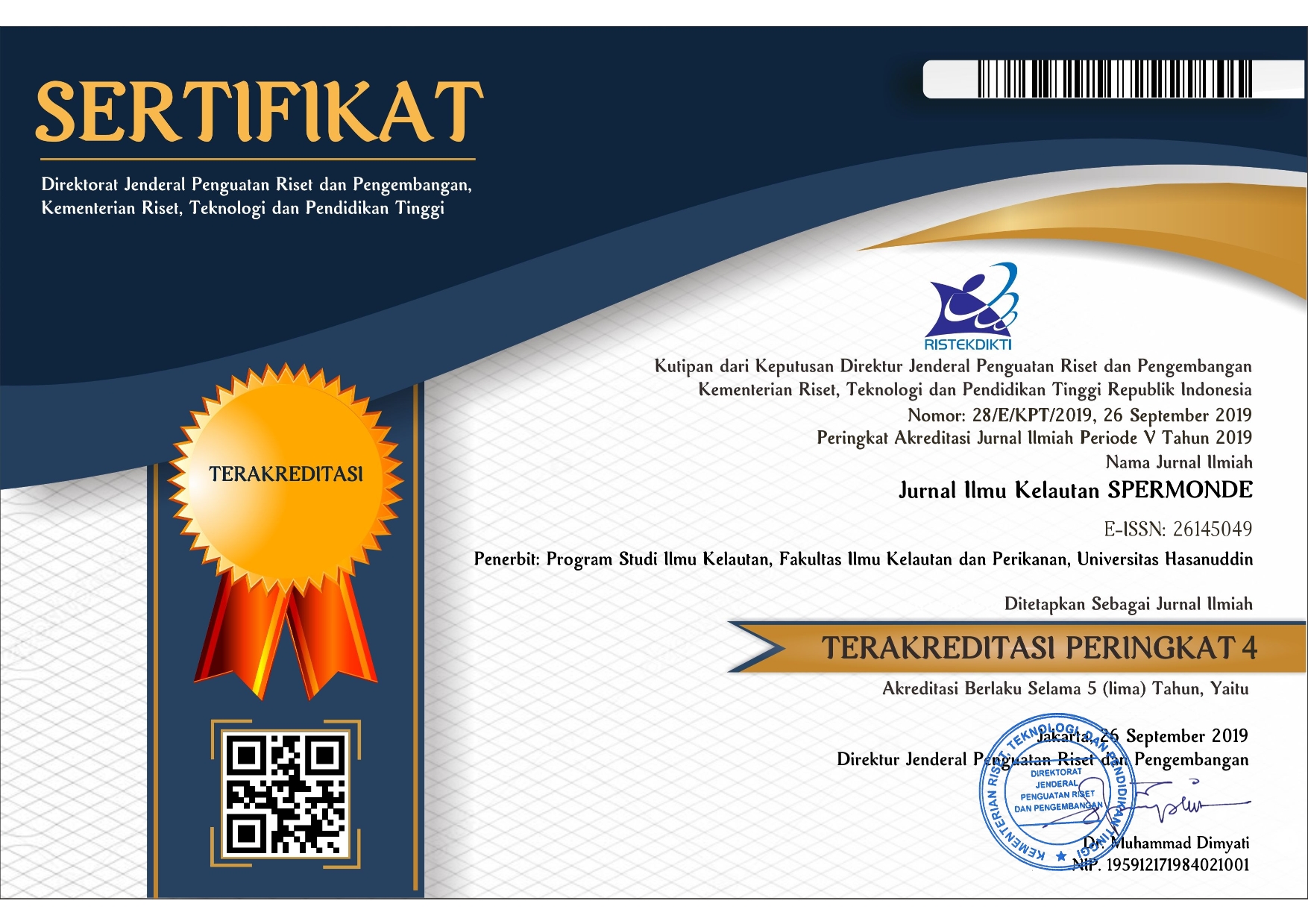THE EFFECT OF TEMPERATURE ON ZOOXANTHELLAE OF ISOPORA PALIFERA AND ACROPORA HYACINTHUS FROM KARANRANG ISLAND, INDONESIA
DOI:
https://doi.org/10.20956/jiks.v4i1.3798Keywords:
Climate change, coral bleaching, temperature rise, abundance of zooxanthellaeAbstract
Climate change and global warming cause massive damage to the environment. One of the major events that arethreatening the marine ecosystem is coral bleaching. Coral bleaching occurs when corals are exposed to above or belownormal temperatures. The aims of this study are to compare the resistance of Isopora palifera and Acropora hyacinthusfrom Karanrang Island to temperature stress. Four treatment temperatures (28ºC, 30ºC, 32ºC, and 34ºC) were tested toassess the role of temperature stress and bleaching to Isopora palifera and Acropora hyacinthus for 48-hours. Theabundance of zooxanthellae counted as the temperature stress variable. The results showed that there was a difference ofcoral response tothe treatment based on the time of experiment, after 48-hours experimentexposed at temperaturetreatment of 34°C the abundance of zooxanthellae from Isopora paliferawas 0,06 x105 cm-2 and the abundance ofzooxanthellae from Acropora hyacinthus is 0,18 x105cm-2. In comparison between species, Isoporapalifera taken fromKaranrang Island was more resistant to temperature stress thanAcroporahyacinthus.Downloads
References
Brown, B.E., Suharsono., 1990. Damage and
recovery of coral reefs affected by El Nino
related seawater warming in the Thousand
Islands, Indonesia. Coral Reefs 8, 163–170.
Brown , B.E., Dunne, R.P., Warner,
M.E.,Ambarsari, I., Fitt,W.K., Gibb, S.W.,
Cummings, D.G., 2000. Damage and
recovery of photosystem II during a
manipulative field experiment on solar
bleaching in the coral Goniastera aspera.
Mar. Ecol. Prog. Ser. 195, 117-124.
Brown, B.E., Dunne, R.P., Goodson, M.S., Douglas,
A.E., 2002. Experience shapes the
susceptibility of a reef coral to bleaching.
Coral Reefs 21, 119-126.
Burke, L., Reytar,K., Spalding, M., Perry, A., 2012.
Reefs at Risk Revisited in TheCoral
Triangle. World Research Institute
Cornils, A., Schulz, J., Schmitt, P., Lanuru, M.,
Richter, C., B, Sigrid., Schnack-Schie.
(2010). Mesozooplankton distribution in the
Spermonde Archipelago (Indonesia,
Sulawesi) with special reference to the
Calanoida (Copepoda). Deep-Sea Research II
(2010) 2076–2088.
Coles SL., Jokiel PL., Lewis CR(1976). Thermal
Tolerance in Tropical versus Subtropical
Pacific Reef Corals. Pacific Science, 30 (2):
-1 66.
Dustan, P. 1999. Coral reefs under stress: sources of
mortality in the Florida Keys. Nat. Res.
Forum 23:147–155.
Fitt, W.K. & Warner, M.E., 1995. Bleaching
Patterns of Four Species of Carribean Reef
Corals. The Biological Bulletin, 189 (3):
-307.
Fitt, W.K, Brown, B.E, Warner, M.E, Dunne, R.P.,
Coral Bleaching: Interpretation of
Thermal Tolerance Limits and Thermal
Thresholds in Tropical Corals. Coral Reefs.
Goreau, T., Mc Clanahan, T., Hayes, R., & Al
Strong., 2000. Conservation of Coral Reefs
after the 1998 Global Bleaching Event.
Conservation Biology, 14 (1): 5–15.
Higuchi, T., Fujimura, H., Hitomi, Y., Arakaki, T.,
Oomori, T., Suzuki, Y., 2010.
Photochemichal formation of hydroxyl
radicals in tissue extracts of the coral
Galaxea fascicularis. Photochem. Photobiol.
, 1421-1426.
Hoegh-Guldberg O., 1994. Mass-bleaching of coral
reefs in French Polynesia, April 1994.
Climate Impacts Series, 1: Greenpeace
International, 36 pp. International.
Hoegh-Guldberg, O., 1999. Climate change, coral
bleaching and the future of the world‟s Coral
Reefs. Mar. Freshw. Res. 50, 839-866.
IPCC., 2007. Climate Change 2007: Synthesis
Report. Contribution of Working Groups I, II
and III to the Fourth Assessment Report of
the Intergovernmental Panel on Climate
Change [Core Writing Team, Pachauri, R.K
and Reisinger, A. (eds.)]. IPCC, Geneva,
Switzerland, 104 pp.
Jones, 1997 Regulation and control of intracellular
algae (zooxanthellae) in hard corals. Phil.
Trans. R. Soc B. Lond. 352, 457–468.
Li,S., 2007. Recent development in coral reef
bleaching research, Acta Ecol. Sin. 27 (5)
(2007) 2059–2069.
Marsh, J.A. Jr., 1970. Primary productivity of reefbuilding
calcareous red algae. Ecology 51:
-263.
Marshall, P.A.&Baird, AH., 2000. Bleaching of
corals on the Great Barrier Reef: differential
susceptibilities among taxa. Coral Reefs, 19,
–163.
McCowan, Domonique, M., Pratchett, Morgan S. ,
Paley, Alison S., Seeley, Michelle., B
, Andrew H. 2011. A comparison of two
methods of obtaining densities of
zooxanthellae in Acropora hyachintus.
Galaxea, Journal of Coral Reef Studies 13:
-34.
Perez, S. F., Cook, C. B. and Brooks, W. R. (2001).
The role of symbiotic dinoflagellates in the
temperature-induced bleaching response of
the subtropical sea anemone Aiptasia pallida.
J. Exp. Mar. Biol. Ecol. 256, 1- 14.
Rowan, R., Knowlton, N., Baker, A., Jara, J., 1997.
Landscape ecology of algal symbionts
creates variation in
episodes of coral bleaching. Nature 388,
–269.
Stone, L., Rajagopalan, B., Bhasin, H., Loyla,
Y.1999. Mass Coral Reef Bleaching: A
Recent Outcome of Increased El Niño Activity. Ecology Letters. Volume 2, Issue 5
September 1999.
Taylor, D.L., 1974. Symbiotic marine algae:
taxonomy and bio- logical fitness. In:
Vernberg WB (ed) Symbiosis in the sea.
University of South Carolina Press,
Columbia, p 245-262.
Trench, R., 1979. The cell biology of plant–animal
symbiosis, Annu. Rev. Plant Physiol.30:485–
Trench, R. K.& Blank, R.J., 1987.Symbiodinium
Microadriaticumfreudenthal, S. Goreauii Sp.
Nov., S. Kawagutii Sp. Nov. And S. Pilosum
Sp. Nov.: Gymnodinioid Dinoflagellate
Symbionts of Marine Invertebrates. Journal
of phycology.Volume 23, Issue 3 September
pages 469–481.
Veal, C.J., Carm, M., Fine, M., Hoegh-Guldberg,
O., 2010. Increasing the Accuracy of Surface
Area Estimation Using Single Wax Dipping
of Coral Fragments. Coral Reefs. Volume 29
(4) : 893-897.
Warner, M. E., Fitt, W. K., Schmidt, G. W. (1996).
The effects of elevated temperature on the
photosynthetic efficiency of zooxanthellae in
hospite from four different species of reef
coral: a novel approach. Plant, Cell &
Environment, 19: 291–299.
doi:10.1111/j.1365-3040.1996.tb00251.x.
Weis V.M., 2008. Commentary Cellular
mechanisms of Cnidarian bleaching: stress
causes the collapse of symbiosis. The Journal
of Experimental Biology 211, 3059-3066
Published by The Company of Biologists
doi:10.1242/jeb.009597.
Wilkerson, F. P., Kobayashi, D., Muscatine, L.,
Mitotic index and size of symbiotic
algae in Caribbean reef corals. Coral Reefs 7:
-36.
Williams, E..H..Jr. & Bunkley-Williams, L., 1990.
The world-wide coral reef bleaching cycle
and related sources of coral mortality. Atoll
Research Bulletin, 355: 1-72.
Downloads
Published
Issue
Section
License
Copyright (c) 2018 Jurnal Ilmu Kelautan SPERMONDE

This work is licensed under a Creative Commons Attribution-NonCommercial 4.0 International License.

This work is licensed under a Creative Commons Attribution 4.0 International License










